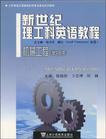新世纪理工科英语教程
出版时间:2008-10 出版社:上海外语教育出版社 作者:张振烈,卜玉坤,何林 主编 页数:459
前言
大学英语教学大纲(修订本)规定大学英语教学分为基础阶段(一至二年级)和应用提高阶段(三至四年级)。应用提高阶段的教学包括专业英语(Subject.Based English,简称SBE)和高级英语(Advanced English,简称AE)两部分。大纲明确指出:“大学英语教学的目的是培养学生具有较强的阅读能力和一定的听、说、写、译能力,使他们能用英语交流信息。……以适应社会发展和经济建设的需要。”新世纪对人才在外语方面提出了更高的要求。抓好大学英语应用提高阶段的教学已势在必行。编写本教材的目的是帮助理工科学生在应用提高阶段进一步发展、巩固和提高基础阶段已掌握的读、听、写、说、译五种技能,并使部分有一定口语基础的学生在听说能力方面也能有较大的提高,以适应21世纪对高级人才的需求。 本教材主要适用于已完成基础阶段学习的高等学校理工科本科生,为应用提高阶段的必修课和选修课教材,也可用作研究生教学或工程技术人员的外语培训教材。 全套教材由专业教师和英语教师合作编写而成。它以英国语言学家H.G.Widdowson的交际法理论为依据,着重解决语言运用能力的培养问题,使学生将基础阶段已掌握的英语语言知识和技能在自己的专业领域中得到进一步实践和应用,从而达到能以英语为工具获取和交流信息的教学目的。
内容概要
本书为Mechanical Engineering分册,供机械工程及相关专业的大学本科学生作专业英语(Subject—Based English,简称SBE)即大学第五、六学期教材使用,约需68学时。 本书分Text(课文)、Practical Writing(实用文写作)和Glossary(生词表)三部分。Text(书中不注明)分20个单元,每个单元由Reading and Comprehension,Reading andPractice和Reading and Translation三部分组成。全书选材面向21世纪的要求,以反映时代特色。材料选自国外原版教材、文选、论著、会议论文、实用文件、报刊杂志等。内容涉及机械T程及相关专业的基本物理概念、基础工程知识、发展简史或重大发明创造、人物传记、重要组织机构简介以及学科发展动向。
书籍目录
UNIT ONE Reading and Comprehension Introduction to Mechanical Engineering Reading and Practice The Meaning of Design Reading and Translation EngineersUNIT TWO Reading and Comprehension History of the Computer Reading and Practice Manufacturing Engineering Reading and Translation Engineering Manufacturing ReviewUNIT THREE Reading and Comprehension How Do Homing Pigeons Find Home? Reading and Practice Properties of Metals Reading and Translation Engineering MaterialsUNIT FOUR Reading and Comprehension The Three Mile Island Accident Reading and Practice Product Quality Reading and Translation Quality ControlUNIT FIVE Reading and Comprehension The Classification of Casting Reading and Practice Heat Treatment Reading and Translation Forming ProcessesUNIT SIX Reading and Comprehension Mechanisms and Machines Reading and Practice Spur Gears Reading and Translation Flexible Mechanical ElementsUNIT SEVEN Reading and Comprehension Joining Processes Reading and Practice Rolling Contact Bearings Reading and Translation ShaftsUNIT EIGHT Reading and Comprehension Power of Machines Reading and Practice Clutches, Brakes, Couplings, and Flywheels Reading and Translation Introduction to Traction DrivesUNIT NINE Reading and Comprehension Theory of Metal Cutting Reading and Practice Cutting Tool Materials, Wear, and Life Reading and Translation Introduction to Chips and ChatterUNIT TEN Reading and Comprehension Machinability Reading and Practice Nontraditional Machining Operations Reading and Translation Oblique versus Orthogonal CuttingUNIT ELEVEN Reading and Comprehension Headstock of Engine Lathe Reading and Practice Size, Bed, Tailstock and Carriage of Engine Lathe Reading and Translation Milling Machines, Shapers, Planers, and Grinding MachinesUNIT TWELVE Reading and Comprehension Mechanization, Automation Reading and Practice Introduction to Time Series Analysis Reading and Translation ReliabilityUNIT THIRTEEN Reading and Comprehension Computer Hardware Reading and Practice Programming Languages Reading and Translation Computer CategoriesUNIT FOURTEEN Reading and Comprehension Types of Mechanical Drawing Reading and Practice Tolerances, Fits, and Interchangeability Reading and Translation Introduction to CAD of DraftingUNIT FIFTEEN Reading and Comprehension Fundamentals of Numerical Control Reading and Practice Classification of NC Systems Reading and Translation Applications of NCUNIT SIXTEEN Reading and Comprehension Group Technology (GT) Reading and Practice Applications of Group Technology Reading and Translation CAPPUNIT SEVENTEEN Reading and Comprehension Introduction to Robots Reading and Practice Programming Robots Reading and Translation Robot ApplicationUNIT EIGHTEEN Reading and Comprehension Just-in-Time Concept Reading and Practice Introduction to Simulation Reading and Translation Simulation. Current Use in Decision SupportUNIT NINETEEN Reading and Comprehension Concepts of Computer Control Reading and Practice Automation and Adaptive Control Reading and Translation Dynamic Analysis of Mechanical Systems by ComputerUNIT TWENTY Reading and Comprehension Flexible Manufacturing Systems and Workcells Reading and Practice Computer-Integrated Manufacturing Reading and Translation Introduction to Computer ControlPRACTICAL WRITINGGLOSSARYAPPENDIXSelected Popular Words in Mechanical Engineering
章节摘录
1. Design all functional and physical characteristics to be as simple as possible. : Complexi ty of the design has a direct bearing on production costs. As a general rule, the serv ice life of a part can be extended considerably when the design of the parts is simpleand sturdy. The loadcarrying capacity of a part is more predictable when the designconfiguration is straightforward and uncomplicated. 2. Design for the most economical production method.It is particularly important to keepthe scrap problem in mind. The ratio of the weight of original material required tothe weight of the finished piece provides a clue to possible cost reductions. This is especially true for highvolume production of parts. Weight considerations often result in a reduction of scrap costs as well as a substantial cost savings of machining time. 3. Design for a minimum number of machining operations.The fewer operations necessa ry to complete a part to drawing specifications, the lower the cost. Needless fancy or nonfunctional configurations requiring extra operations and materials should be omitted from the design. Actually, the greatest savings obtained in designing for production usually result from a reduction in the number of separate processing operations required to complete a part. 4. Specify finish and accuracy no greater than are actually needed.Tolerance on finish and on dimensions plays an important part in achieving a practical production design. The specification of needlessly close tolerances and an unreasonable degree of surface roughness always result in excessive and, in some cases, prohibitive cost. 5. Accessibility of different parts or areas. All components and parts of the productshould be accessible to facilitate regular cleaning and maintenance work. Unaccessible areas lend themselves to the accumulation of dirt with the final outcome being corrosion and / or malfunctioning of the product, Crevices, narrow slots, and bolts and nuts located in places where it is difficult to clean, mount, tighten or loosen, or remove them should be avoided.
编辑推荐
《新世纪理工科英语教程:机械工程(学生用书)》为Mechanical Engineering分册,供机械工程及相关专业的大学本科学生作专业英语(Subject—Based English,简称SBE)即大学第五、六学期教材使用,约需68学时。
图书封面
评论、评分、阅读与下载
用户评论 (总计1条)
- 书还不错的 以后也会用的
